Cable Force Identification for Pre-Stressed Steel Structures Based on a Multi-Frequency Fitting Method
Abstract
:1. Introduction
2. Cable Vibration and Cable Force Identification Theory
2.1. Equation of Cable Vibration
2.2. Theoretical Vibration Model of Continuous Multi-Span Cable Element
2.3. Multi-Frequency Fitting Method for Continuous Multi-Span Cables
3. Experimental Verification of Cable Force Identification Theory
3.1. Multi-Frequency Fitting Method for Cable Force Identification and Its Verification
- First, a multi-span cable vibration model is established. The characteristic equation of a cable supported by brace struts, with m spans and n unknown stiffness constraints, is given by:
- The N + 1 natural frequencies, ωi, are obtained from the experimental data. N equations for the cable force T and n stiffness constraints are established. The optimization algorithm model is designed with the following optimization objective function:
- To calculate the cable force T, an unconstrained optimization algorithm is adopted to select the initial cable force parameters. The values of the n + 1 unknown parameters are calculated via regression for the optimization objective function.
- The accuracy of the obtained cable force value is verified, and conclusions are drawn based on the calculation.
3.1.1. Single-Cable Test—Phase I
3.1.2. Cable-Stayed Structure Test—Phase II
3.1.3. Unidirectional String Structure Test
3.1.4. Bidirectional String Structure Test
4. Realization and Development of Cable Safety Monitoring System
4.1. System Function Design
4.2. System Hardware Integration
- Sensors: Lance LC0116T-2 low-frequency ICP piezoelectric uniaxial acceleration sensors were used in this paper. The technical indices of the sensor are listed in Table 6.
- Signal acquisition equipment, the Cm4016 conditioning module for sensors, was used. The acquisition module was a Lance CBook 2000-P specific dynamic acquisition instrument capable of accepting 16-channel parallel input acquisition simultaneously with an effective resolution of 16 bit. A cassette acquisition device was used as an intelligent signal analyzer, which can be used with computers and software, to realize the full automation of large-capacity multichannel data acquisition, display, oscilloscope measurements, readings, waveform analysis, spectrum analysis, digital filtering, integral and differential, calculation of waveform analysis, storage, printing, copying, etc.
- The specific data acquisition and analysis software of the DASP-V10 engineering edition produced by the China Orient Institute of Noise and Vibration was utilized for the data analysis. Its design functions included large-capacity signal oscillograph sampling and the analyses of multi-trace time domain, multi-trace self-spectrum, autocorrelation, cross-correlation, cross-power spectrum, and transfer function.
4.3. Visual Software System
- The cable force calculation for the simplified model included three types of specific boundaries: cables with both ends hinged, one end fixed and the other hinged, and both ends fixed, as illustrated in Figure 20.
- For single-cable force calculation with an arbitrary boundary, the cable force and constraint stiffness were calculated according to the input basic cable parameters and multi-order frequencies obtained by the spectrum analysis, as illustrated in Figure 21.
- For the multi-span cable force calculation, the multi-frequency fitting method was used to calculate the cable force and the cable stiffness constraints according to the input cable parameters and multi-order frequencies, as illustrated in Figure 22.
5. Conclusions
Author Contributions
Funding
Conflicts of Interest
References
- Mehrabi, A.B. In-service evaluation of cable-stayed bridges, overview of available methods and findings. J. Bridge Eng. 2006, 11, 716–724. [Google Scholar] [CrossRef]
- Kim, S.W.; Kim, N.S. Dynamic characteristics of suspension bridge hanger cables using digital image processing. NDT E Int. 2013, 59, 25–33. [Google Scholar] [CrossRef]
- Xue, S.L.; Shen, R.L. Real time cable force identification by short time sparse time domain algorithm with half wave. Measurement 2020, 152, 107355. [Google Scholar] [CrossRef]
- Nazarian, E.; Ansari, F.; Zhang, X.; Taylor, T. Detection of tension loss in cables of cable-stayed bridges by distributed monitoring of bridge deck strains. J. Struct. Eng. 2016, 142, 04016018. [Google Scholar] [CrossRef]
- Zhang, L.X.; Qiu, G.Y.; Chen, Z.S. Structural health monitoring methods of cables in cable-stayed bridge: A review. Measurement 2021, 168, 108343. [Google Scholar] [CrossRef]
- Qin, J.; Gao, Z.G.; Qian, Y.X.; Wang, F. Theory and Technology of Cable Force Test for Prestressed Steel Structure; China Architecture & Building Press: Beijing, China, 2010. (In Chinese) [Google Scholar]
- Rebelo, C.; Júlio, E.; Varum, H.; Costa, A. Cable tensioning control and modal identification of a circular cable-stayed footbridge. Exp. Tech. 2010, 34, 62–68. [Google Scholar] [CrossRef]
- Bao, Y.; Shi, Z.; Beck, J.L.; Li, H.; Hou, T.Y. Identification of time-varying cable tension forces based on adaptive sparse time-frequency analysis of cable vibrations. Struct. Control Health Monit. 2017, 24, e1889. [Google Scholar] [CrossRef]
- Pacitti, A.; Peigney, M.; Bourquin, F.; Lacarbonara, W. Experimental data based cable tension identification via nonlinear static inverse problem. Procedia Eng. 2017, 199, 453–458. [Google Scholar] [CrossRef]
- Geier, R.; De Roeck, G.; Flesch, R. Accurate cable force determination using ambient vibration measurements. Struct. Infrastruct. Eng. 2006, 2, 43–52. [Google Scholar] [CrossRef]
- Yu, Z.R.; Shao, S.; Liu, N.; Zhou, Z.; Feng, L.; Du, P.; Tang, J. Cable tension identification based on near field radiated acoustic pressure signal. Measurement 2021, 178, 109354. [Google Scholar] [CrossRef]
- Yao, Y.D.; Yan, M.; Bao, Y. Measurement of cable forces for automated monitoring of engineering structures using fiber optic sensors: A review. Autom. Constr. 2021, 126, 103687. [Google Scholar] [CrossRef]
- Zheng, R.; Liu, L.; Zhao, X.; Chen, Z.; Zhang, C.; Hua, X. Investigation of measurability and reliability of adhesive-bonded built-in fiber Bragg grating sensors on steel wire for bridge cable force monitoring. Measurement 2018, 129, 349–357. [Google Scholar] [CrossRef]
- Li, X.X.; Ren, W.X.; Bi, K.M. FBG force-testing ring for bridge cable force monitoring and temperature compensation. Sens. Actuators A. 2015, 223, 105–113. [Google Scholar] [CrossRef]
- Hu, D.; Guo, Y.; Chen, X.; Zhang, C. Cable force health monitoring of Tongwamen bridge based on fiber Bragg grating. Appl. Sci. 2017, 7, 384. [Google Scholar] [CrossRef] [Green Version]
- Feng, D.; Scarangello, T.; Feng, M.Q.; Ye, Q. Cable tension force estimate using novel noncontact vision-based sensor. Measurement 2017, 99, 44–52. [Google Scholar] [CrossRef]
- Gentile, C.; Cabboi, A. Vibration-based structural health monitoring of stay cables by microwave remote sensing. Smart Struct. Syst. 2015, 16, 263–280. [Google Scholar] [CrossRef]
- Liu, Y.; Xie, J.Z.; Tafsirojjaman, T.; Yue, Q.; Tan, C.; Che, G. CFRP lamella stay-cable and its force measurement based on microwave radar. Case Stud. Constr. Mater. 2022, 16, e00824. [Google Scholar] [CrossRef]
- Chen, C.C.; Wu, W.H.; Tseng, H.Z.; Chen, C.; Lai, G. Application of digital photogrammetry techniques in identifying the mode shape ratios of stay cables with multiple camcorders. Measurement 2015, 75, 134–146. [Google Scholar] [CrossRef]
- Du, W.K.; Lei, D.; Bai, P.X.; Zhu, F.; Huang, Z. Dynamic measurement of stay-cable force using digital image techniques. Measurement 2020, 151, 107211. [Google Scholar] [CrossRef]
- Jo, H.C.; Kim, S.H.; Lee, J.; Sohn, H.; Lim, Y.M. Sag-based cable tension force evaluation of cable-stayed bridges using multiple digital images. Measurement 2021, 186, 110053. [Google Scholar] [CrossRef]
- Russell, J.C.; Lardner, T.J. Experimental determination of frequencies and tension for elastic cables. J. Eng. Mech. 1998, 124, 1067–1072. [Google Scholar] [CrossRef]
- Irvine, H.M. Cable Structures; The MIT Press: Cambridge, MA, USA, 1981. [Google Scholar]
- Fang, Z.; Wang, J.Q. Practical formula for cable tension estimation by vibration method. J. Bridge Eng. 2012, 17, 161–164. [Google Scholar] [CrossRef]
- Kim, B.H.; Park, T. Estimation of cable tension force using the frequency-based system identification method. J. Sound Vib. 2007, 304, 660–676. [Google Scholar] [CrossRef]
- Wang, J.; Liu, W.Q.; Wang, L.; Han, X. Estimation of main cable tension force of suspension bridges based on ambient vibration frequency measurements. Struct. Eng. Mech. 2015, 56, 939–957. [Google Scholar] [CrossRef]
- Ceballos, M.A.; Prato, C.A. Determination of the axial force on stay cables accounting for their bending stiffness and rotational end restraints by free vibration tests. J. Sound Vib. 2008, 317, 127–141. [Google Scholar] [CrossRef]
- Nam, H.; Nghia, N.T. Estimation of cable tension using measured natural frequencies. Procedia Eng. 2011, 14, 1510–1517. [Google Scholar] [CrossRef] [Green Version]
- Chen, C.C.; Wu, W.H.; Leu, M.R.; Lai, G. Tension determination of stay cable or external tendon with complicated constraints using multiple vibration measurements. Measurement 2016, 86, 182–195. [Google Scholar] [CrossRef]
- Chen, C.C.; Wu, W.H.; Chen, S.Y.; Lai, G. A novel tension estimation approach for elastic cables by elimination of complex boundary condition effects employing mode shape functions. Eng. Struct. 2018, 166, 152–166. [Google Scholar] [CrossRef]
- Yan, B.F.; Yu, J.; Soliman, M. Estimation of cable tension force independent of complex boundary conditions. J. Eng. Mech. 2015, 141. [Google Scholar] [CrossRef]
- Yan, B.F.; Chen, W.B.; Yu, J.Y.; Jiang, X. Mode shape-aided tension force estimation of cable with arbitrary boundary conditions. J. Sound Vib. 2019, 440, 315–331. [Google Scholar] [CrossRef]
- Ma, L. A highly precise frequency-based method for estimating the tension of an inclined cable with unknown boundary conditions. J. Sound Vib. 2017, 409, 65–80. [Google Scholar] [CrossRef]
- Ma, L.; Xu, H.; Munkhbaatar, T.; Li, S. An accurate frequency-based method for identifying cable tension while considering environmental temperature variation. J. Sound Vib. 2021, 490, 1–16. [Google Scholar] [CrossRef]
- Zhang, S.H.; Shen, R.L.; Wang, Y.; De Roeck, G.; Lombaert, G.; Dai, K. A two-step methodology for cable force identification. J. Sound Vib. 2020, 472, 115201. [Google Scholar] [CrossRef]
- Schlune, H.; PloS, M.; Gylltoft, K. Improved bridge evaluation through finite element model updating using static and dynamic measurements. Eng. Struct. 2009, 31, 1477–1485. [Google Scholar] [CrossRef]
- Wang, R.H.; Gan, Q.; Huang, Y.H.; Ma, H. Estimation of tension in cables with intermediate elastic supports using finite-element method. J. Bridge Eng. 2011, 16, 675–678. [Google Scholar] [CrossRef]
- Liao, W.Y.; Ni, Y.Q.; Zheng, G. Tension force and structural parameter identification of bridge cables. Adv. Struct. Eng. 2012, 15, 983–995. [Google Scholar] [CrossRef]
- Mehrabi, A.B.; Telang, N.M.; Ghara, H.; Fossier, P. Health monitoring of cable-stayed bridges-A case study. Structures 2004, 1–8. [Google Scholar] [CrossRef]
- Pan, H.; Azimi, M.; Yan, F.; Lin, Z. Time-frequency-based data-driven structural diagnosis and damage detection for cable-stayed bridges. J. Bridge Eng. 2018, 23, 04018033. [Google Scholar] [CrossRef]
- Huynh, T.C.; Park, J.H.; Kim, J.T. Structural identification of cable-stayed bridge under back-to-back typhoons by wireless vibration monitoring. Measurement 2016, 88, 385–401. [Google Scholar] [CrossRef]


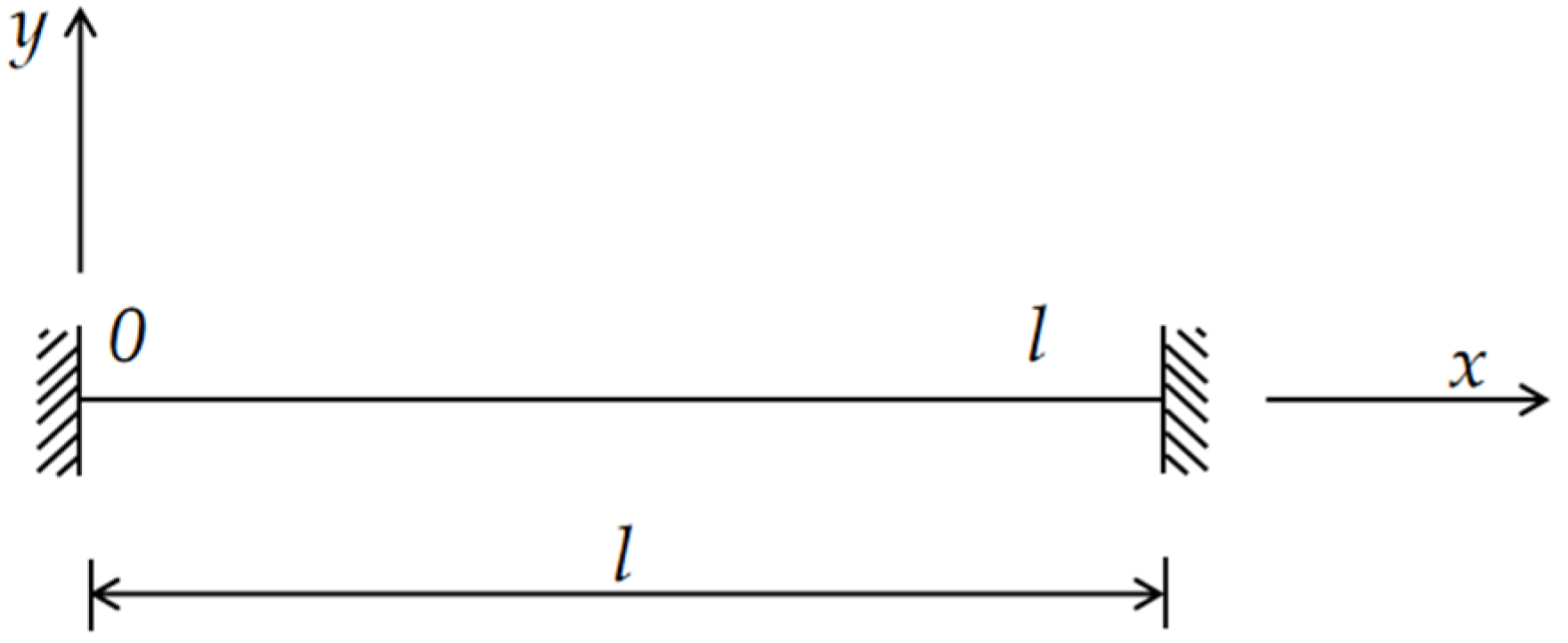
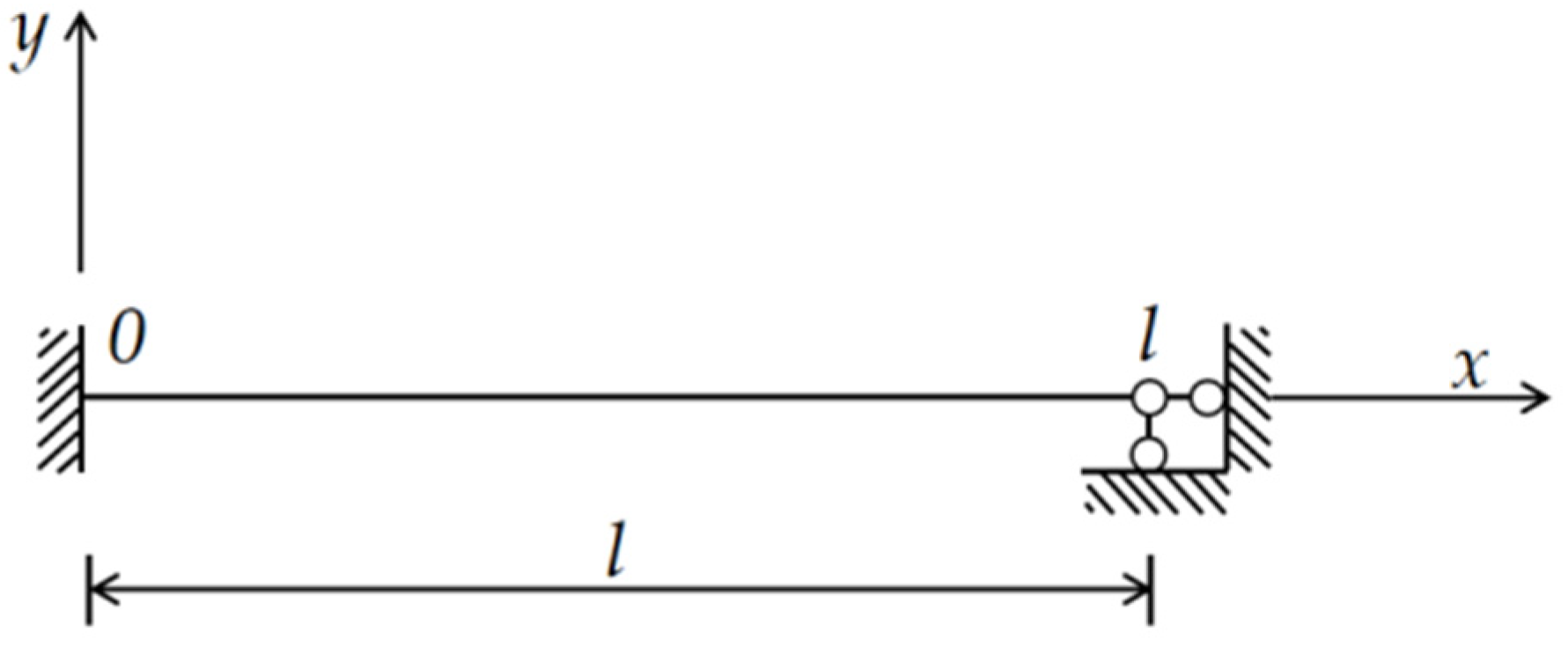





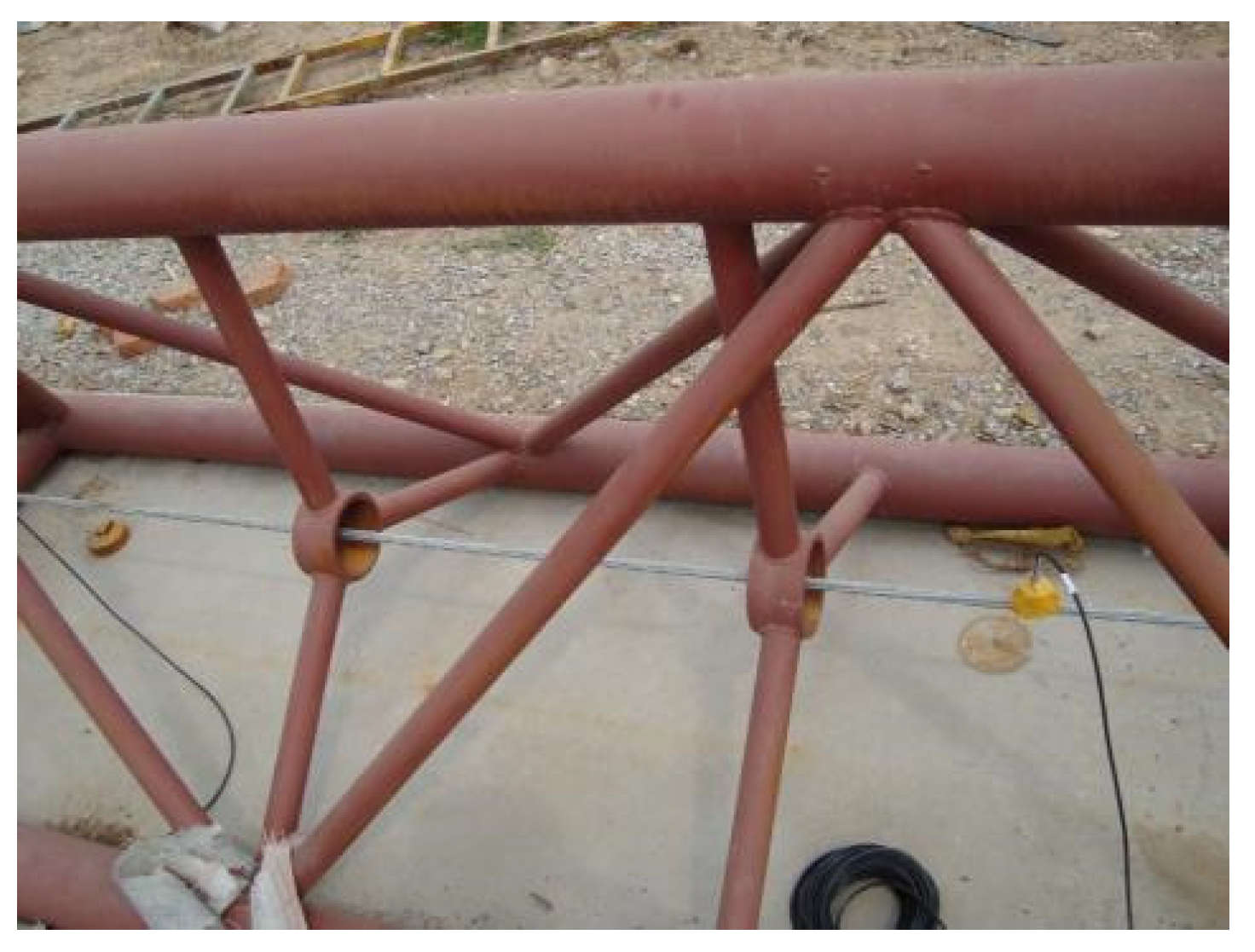
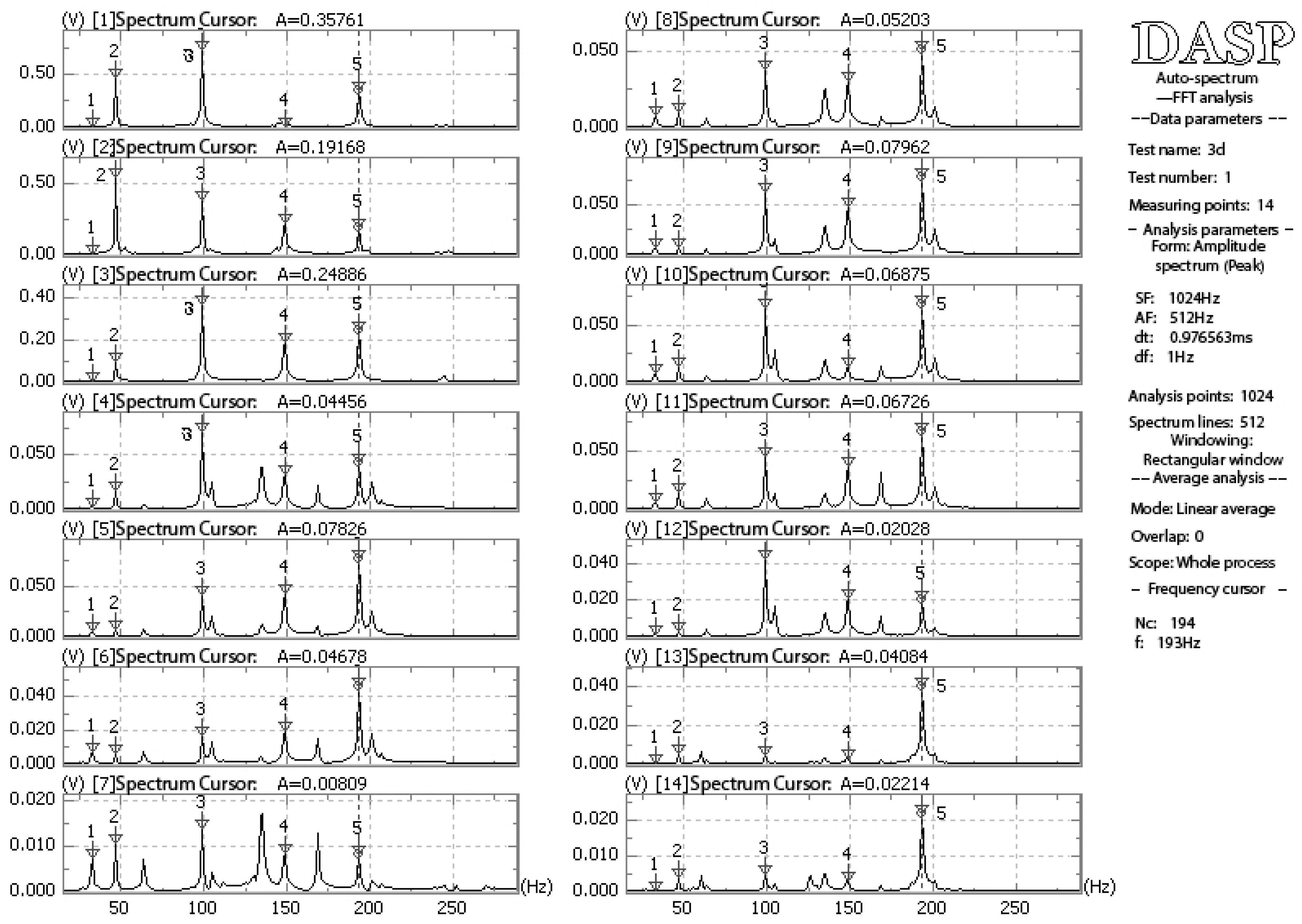


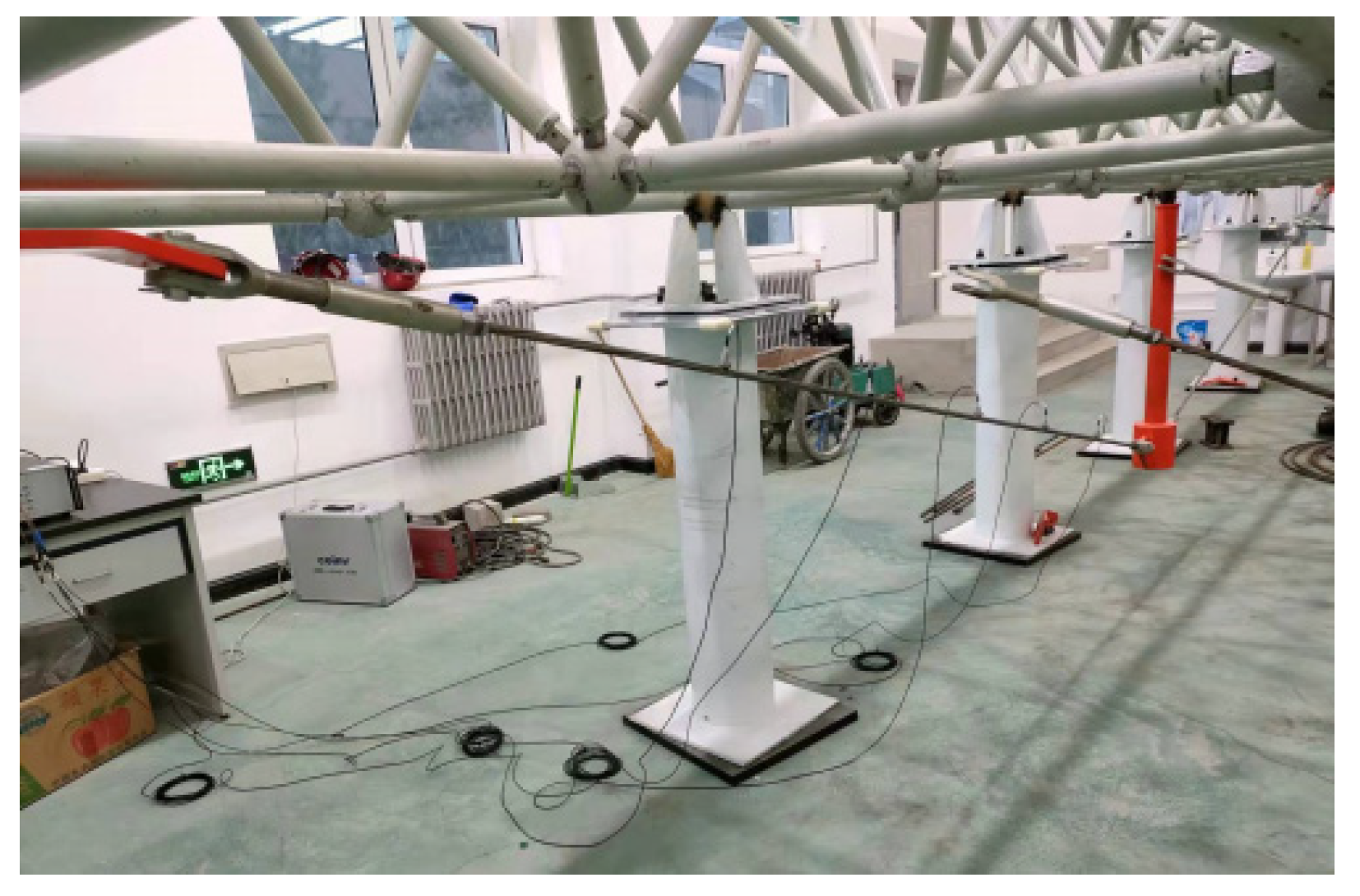
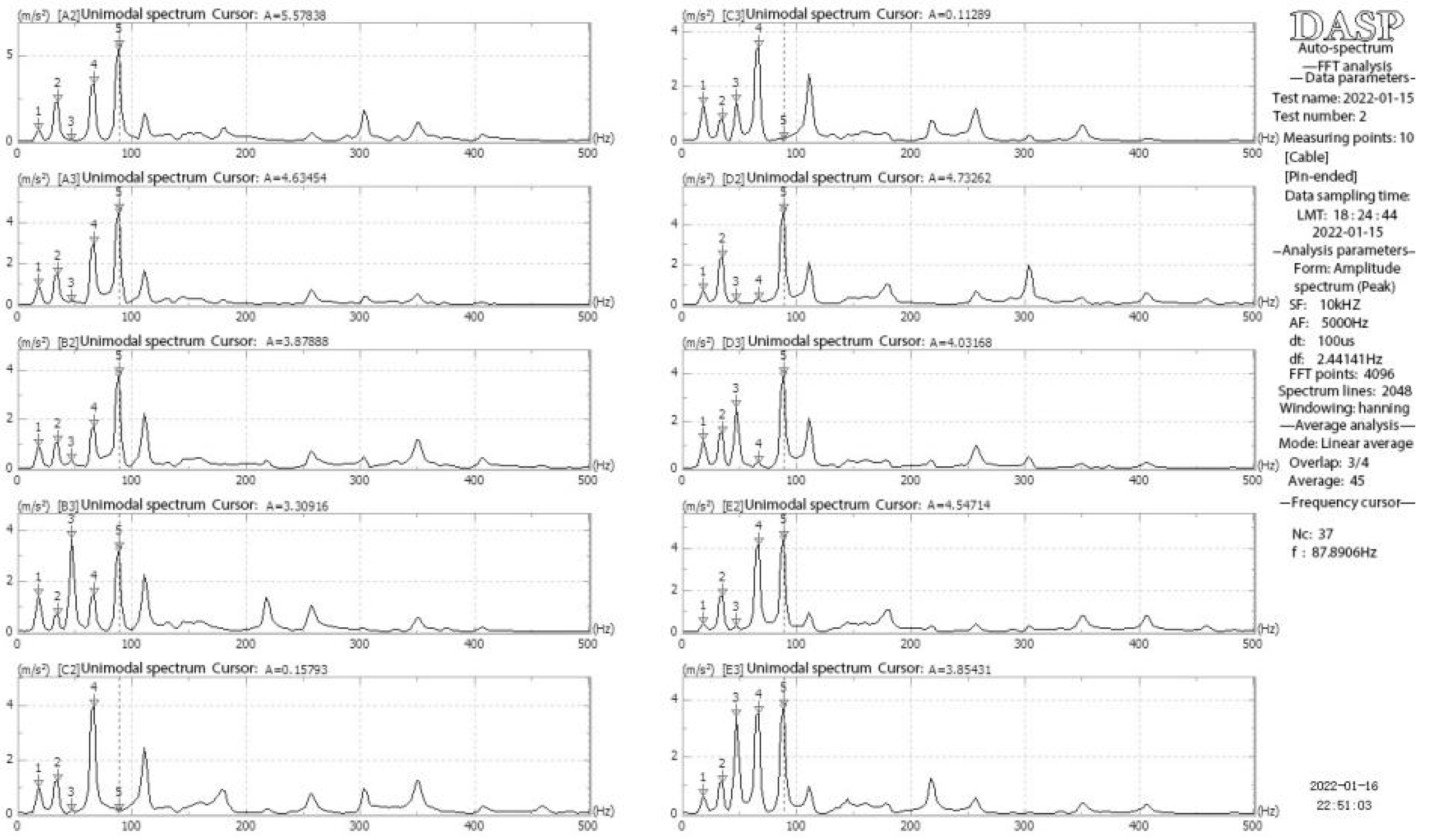
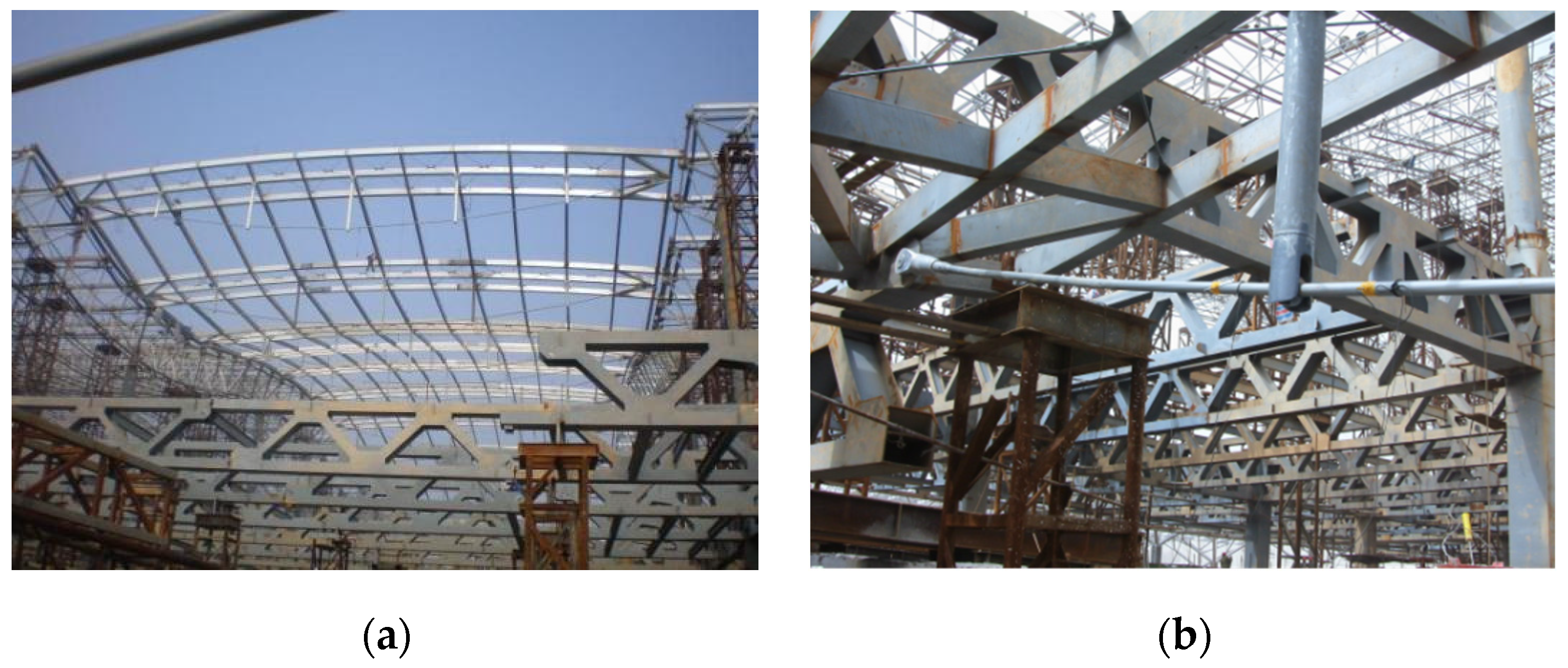
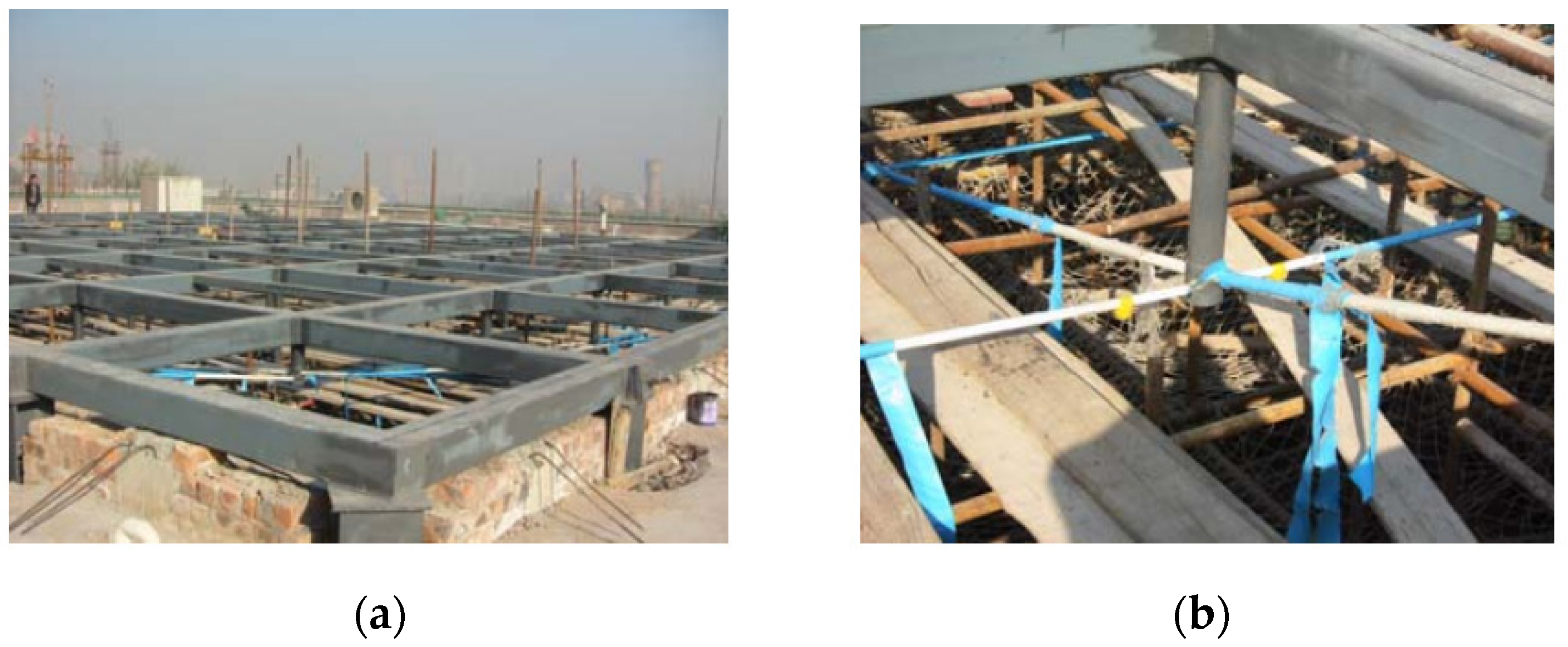

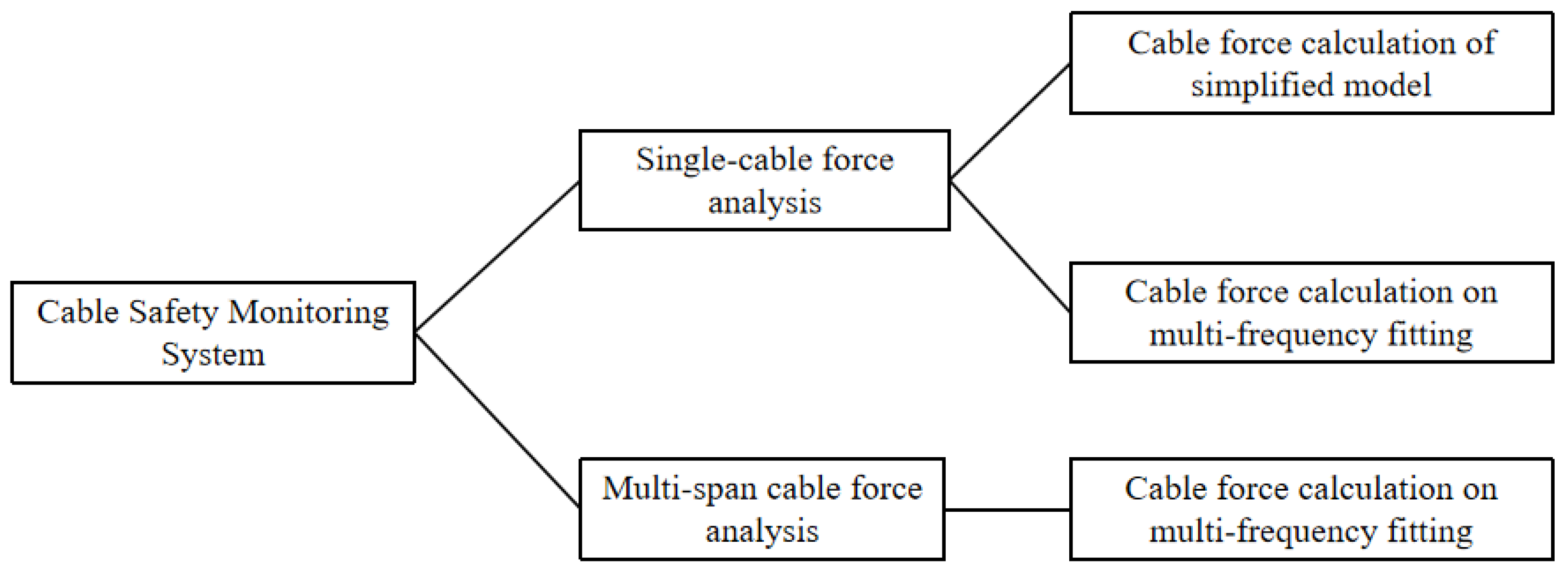



| Order: n | an | bn |
|---|---|---|
| 1 | 0.5 | 0.664178761 |
| 2 | 0.349578 | 0.40003957 |
| 3 | 0.25 | 0.285713409 |
| 4 | 0.206778 | 0.222222241 |
| 5 | 0.166667 | 0.181818178 |
| Calculation Times | Initial Values of Optimization (kN) | Identified Cable Force Values (kN) | Actual Tension Value (kN) |
|---|---|---|---|
| 1 | 89.819 | 89.725 | 90 |
| 2 | 80.000 | 89.725 | |
| 3 | 100.000 | 89.725 |
| Frequency Order | Identified Cable Force Values (kN) | Identified Cable Force Average Values (kN) | Actual Cable Force Value (kN) |
|---|---|---|---|
| 1 | 21.385 | 18.872 | 20.35 |
| 2 | 20.881 | ||
| 3 | 16.132 | ||
| 4 | 17.355 | ||
| 5 | 18.606 |
| Calculation Times | Initial Values of Optimization (kN) | Constraint Stiffness of the Left Support (kN·m2) | Constraint Stiffness of the Right Support (kN·m2) | Identified Cable Force Values (kN) | Identification Stiffness of Left Support (kN·m2) | Identification Stiffness of Right Support (kN·m2) | Actual Tension Value (kN) |
|---|---|---|---|---|---|---|---|
| 1 | 415.534 | 1.0 | 1.0 | 287.815 | 151.412 | 92.340 | 300 |
| 2 | 322.956 | 1.0 | 1.0 | 286.748 | 147.336 | 43.374 |
| Calculation Times | Initial Values of Optimization (kN) | Constraint Stiffness of the Left Support (kN·m2) | Constraint Stiffness of the Right Support (kN·m2) | Identified Cable Force Values (kN) | Identification Stiffness of Left Support (kN·m2) | Identification Stiffness of Right Support (kN·m2) | Actual Tension Value (kN) |
|---|---|---|---|---|---|---|---|
| 1 | 50.768 | 1.0 | 1.0 | 54.354 | 3.7976 | 3.187 | 55 |
| 2 | 55.317 | 1.0 | 1.0 | 55.386 | 3.8576 | 6.026 |
| Technical Indexes | Index Value | Technical Indexes | Index Value |
|---|---|---|---|
| Response frequency | 0.05–300 kHz | Sensitivity of the sensor | 2.5 V/g |
| Effective stationary response frequency | Approximately 0.1–230 kHz | Sensitivity of the large range sensor | 25 mV/g |
| Natural frequency | 3000 kHz | Weight | 220 g |
| Nonlinear response | ≤5% |
Publisher’s Note: MDPI stays neutral with regard to jurisdictional claims in published maps and institutional affiliations. |
© 2022 by the authors. Licensee MDPI, Basel, Switzerland. This article is an open access article distributed under the terms and conditions of the Creative Commons Attribution (CC BY) license (https://creativecommons.org/licenses/by/4.0/).
Share and Cite
Qin, J.; Ju, Z.; Liu, F.; Zhang, Q. Cable Force Identification for Pre-Stressed Steel Structures Based on a Multi-Frequency Fitting Method. Buildings 2022, 12, 1689. https://doi.org/10.3390/buildings12101689
Qin J, Ju Z, Liu F, Zhang Q. Cable Force Identification for Pre-Stressed Steel Structures Based on a Multi-Frequency Fitting Method. Buildings. 2022; 12(10):1689. https://doi.org/10.3390/buildings12101689
Chicago/Turabian StyleQin, Jie, Zhu Ju, Feng Liu, and Qiang Zhang. 2022. "Cable Force Identification for Pre-Stressed Steel Structures Based on a Multi-Frequency Fitting Method" Buildings 12, no. 10: 1689. https://doi.org/10.3390/buildings12101689





